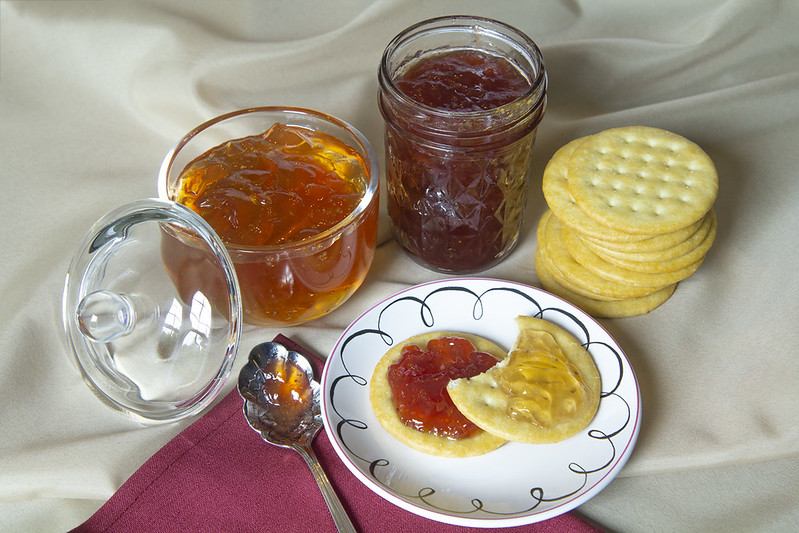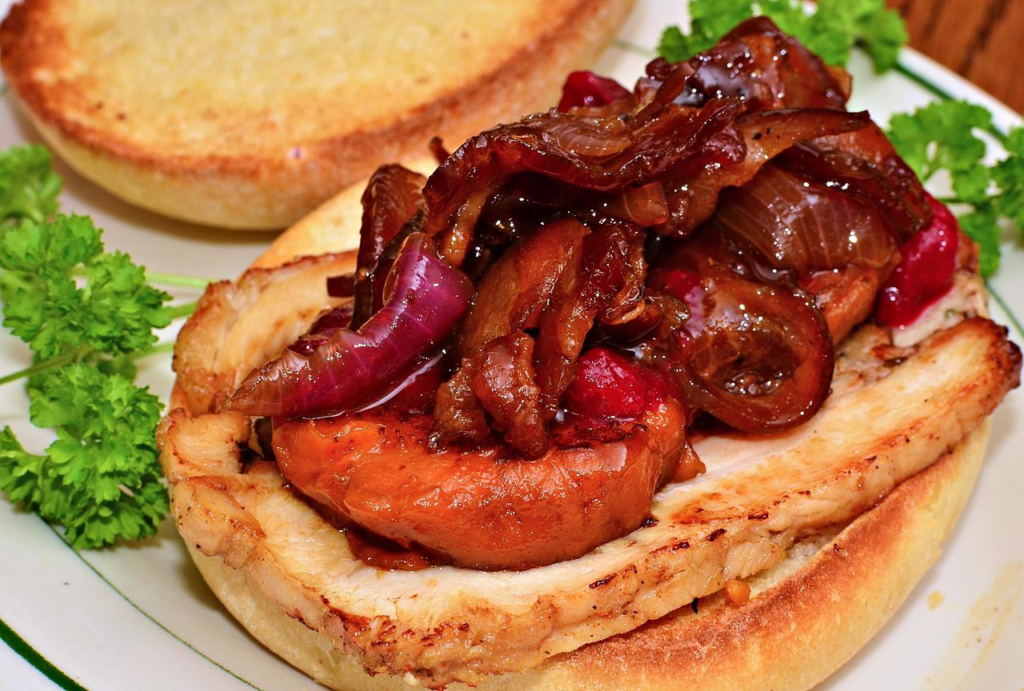Approximately one billion tons of fruit spread are manufactured in the United States each year. There are many ways to preserve fruits and vegetables, and they each result in products with different consistencies depending on preparation methods. Jams include whole pieces of fruit while jellies use only fruit juices. All fruit has some form of pectin in its cell walls. Pectin is a molecule that can gel under proper conditions. Adding sugar, and in some cases acid, allows the fruit mixture to form a gel-like consistency. This gel must be made under very specific conditions to create a palatable consistency. In addition, the sweetness of the fruit is often balanced with tartness. With the use of spices and other interesting flavoring agents, savory jams and jellies made with vegetables, fruit, or a combination of the two have become popular. Many chemical engineering processes are necessary to turn fruit and vegetables into a desirable jellified product.

Ingredient Preparation
Preparation of jams and jellies involves the mixing of sugar, acid, and pectin to thicken and preserve the fruit mixture. The state of the fruit at the start of the jam-making process, such as whether it’s frozen, fresh, or ripe, directly affects the product.
Fresh Varieties Used in Making Jam
Most fruit is harvested in season, when growing conditions are favorable. To make the best jams and jellies, the fruit must be ripe so that all of the flavor molecules have developed. Some fruits, such as berries, do not have sufficient pectin to create a gelatinous mixture, so powdered or liquid pectin may be added by including some fruits that are higher in pectin.
While in-season fruit is ideal and will make the best jam, there are not always available sources of fresh fruit year-round in a given area. Preservation methods are used to ensure that excess fruit from the last growing season is still usable. The most common preservation methods are freezing, drying, or pasteurizing fruit and fruit juices.
For freezing, the produce is typically frozen whole or in pieces. See the Refrigeration module for more details on freezing. To dry the fruit, conveyor dryers or the sun’s rays are typically used. See Dryers for more detail. The pre-pasteurization of juices will kill any bacteria that can cause spoilage by heating the juice and maintaining a specific temperature for a set amount of time. The Cheese module has more information on pasteurization.
Cleaning
Before preservation, the fruit is cleaned to remove undesired material such as dirt and stems. Fruit is then cored, peeled, and washed as described in the Canned Foods Module and as seen in the picture below. Vegetables will go through the same process, with the addition of blanching to help take the outer skin off. The difference between canning and making jams and jellies lies in the way the fruit is cooked.

Cooking Process
For fruit jams and jellies, sugar is mixed with the fruit, typically in a 1:1 ratio. If the fruit does not contain enough natural pectin on its own, pectin is added to the fruit sugar mixture. Acid may be added to the fruit if the fruit does not have enough acidity. The acid normally comes in the form of citrus juices. Optimal pH varies based on the recipe being used. The mixture is then boiled in a large container such as an open steam-jacketed stainless-steel kettle. You can visit the Boilers module for more information. It is very important that the jam does not overboil, as this can denature the pectin and cause fruit flavor and color to be lost. The mixture must be attended to during the entire cooking process to skim off any unwanted pulp from the top of the mixture and mix in any excess coagulation.
Boiling can also be done in a vacuum. This helps keep vitamin C from escaping the mixture and also allows the jam to maintain its color. This method is not energy efficient and is time-consuming, though, because the mixture must boil at a lower temperature for a longer time.
Cooling
After cooking, the jam must be cooled until it reaches the point where it is fortified and thick, known as the set point. If the jam is cooled too much, it will break and curdle. It is imperative that the cooling system not exceed temperature set points. Set points depend on the fruit, sugar, and pectin proportions in the mixture. The jam or jelly will be cooled slowly until it is a few degrees above the set point. For large containers, cooling is done using cooled air.
Production
Filling
After the first cooling step, jars are filled with the mixture, leaving room at the top for a vacuum seal. Lids are added, and the jars are conveyed into a temperature-controlled water bath to bring them to the desired set point temperature. Jars are typically made of glass, as it is a cheap ceramic material that conducts heat poorly. In the process of cooling, a vacuum seal is created inside the jar, ensuring no microbes can get in. Jars are then taken out of the water bath and dried before labeling.
Varieties of Jam and Jellies
Depending on the parts of the fruit or vegetable being used, a different product can be made, as shown in the table below.
| Product Type | Fruit Base |
| Jams | Crushed or ground fruit |
| Jelly | Fruit juice |
| Marmalade | Jelly with cooked fruit suspended in it |
| Preserves | Whole fruit in thick, sugary syrup |
| Conserves | Jams made with multiple types of fruit |
Additives
During the cooking and filling process, color additives and spices may be added to enhance the flavor of the jam. Fruit may not provide a rich, appealing color naturally. To compensate, food companies may add color to make the product more attractive to consumers. To make flavors more complex, complementary spices may also be added. The sugar acts as an antibacterial agent, so there is typically no need to add any additional preservatives. If no pectin is available, other thickening agents, such as gelatin, agar, or gum arabic, may be used.
Savory Jams
Jams and jellies are typically very sweet because of their sugar content. Vegetables also contain pectin, though, and can be used by themselves or with a combination of fruit to create savory jams. Since sugars are typically not as readily available in vegetables, vegetables need to be cooked down before use to concentrate the sugar and make it accessible. For example, to make onion jam, which has become very popular in the culinary world, onions are first caramelized so that their natural sugars are readily available. Onion jam is used in cooking in the picture below. The acid used in making savory jams is typically vinegar, and the fruit is typically reduced wine or fruit juice. Other than the initial cooking, all preparation and cooking methods are the same as for other jams.

Packaging
Jam and jelly jars must be dried completely before labeling to keep out unwanted bacteria and ensure the label sticks successfully to the jar. Jars are fragile and must be handled with care during packaging, including packing them loosely and separating them with a partition, to prevent impact shocks. Since glass is a ceramic material and breaks upon large impacts, it is essential to minimize sudden movement in the shipping process. Since they are already well-preserved, there is no need to cool the product unless it is extremely hot. A hot environment may change the consistency and quality of the jam or jelly.
Quality Control
In the initial cooking of the fruit juices, it is important to make sure the microbes are properly pasteurized out of the mixture. This helps avoid contamination of the equipment. To do this, the mixture is heated to a specific temperature for a set amount of time. This ensures there are no uncontrolled processes occurring as a result of outside microbes.
If the lids are properly sealed, they should bow out in the middle due to the pressure forces. Opening the lid should result in a distinct popping noise as the vacuum seal is broken. Jars can be monitored either digitally, by the naked eye, or a combination of the two. If a jar is not properly sealed, it must be resealed to make sure bacteria cannot get into the jar.
Cooling water must be distilled so that it is not contaminated with other substances. Chlorine can be added to keep out microbes so as not to contaminate the jars. Water is typically recycled continuously to limit the contamination that new water could bring.
Acknowledgments
- Wikimedia Commons: Washing Oranges at an Orange Packing Co-op
- Wikimedia Commons: Turkey and sweet potato sandwich with cranberry relish
- Flickr: Jam & Jelly – Photograph by: Sally Robertson
References
- Schafer, W., Wolf, I. D., Driessen, S., & Botzek-Linn, D. (2018). Making jams, marmalades, preserves and conserves. In University of Minnesota Extension.
- Vibhakara, H. S, & Bawa, A. S. (24/8/2012). Manufacturing Jams and Jellies. Handbook of Fruits and Fruit Processing (pp. 229–243). chapter, Oxford, UK: Wiley‐Blackwell.
- Zhao, Y. (2012). Processing Technology, Quality, and Safety (pp. 135-155). N.p.: CRC Press.
Developers
- Austin Potter
- Tamia Middleton
